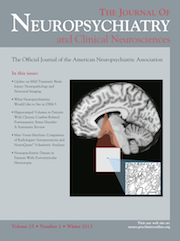Complex Visual Hallucinations Associated With Parietal Infarct
To the Editor: Complex visual hallucinations (CVH) are a common reason for referral to psychiatrists in consultation–liaison and neuropsychiatric settings. Various organic causes of CVH such as narcolepsy–cataplexy syndrome, peduncular hallucinosis, treated idiopathic Parkinson's disease, Lewy-body dementia without treatment, migraine coma, Charles Bonnet syndrome, schizophrenia, hallucinogen-induced states, and epilepsy have been described in the literature.1
We report on a 49-year-old Caucasian women who presented with a 2-day history of acute onset of CVH. She described well-formed human figures flying in the room and animals crawling on the wall as a part of her hallucination. She had good insight into her hallucinations, however, was anxious secondary to the same. There was no diurnal variation in the frequency or intensity of these hallucinations. She denied any other form of hallucinations or any visual defects. Patient’s contributory medical history was significant for uncontrolled diabetes mellitus, hyperlipidemia, hypertension, coronary artery disease, and peripheral vascular disease. The patient had a 40-pack-year history of smoking, however denied alcohol or illicit drug use. The patient was alert and oriented, and a complete neurological examination including a visual field examination was within normal limits. Neuroimaging demonstrated a subacute infarct in the left posterior parietal lobe and complete occlusion of the left internal carotid artery. The patient was started on 40 mg of ziprasidone and was slowly titrated up to a dose of 60 mg twice a day, with complete resolution of her symptoms.
The retinogeniculocalcarine tract is responsible for carrying optical information from the retina to the visual cortex. It transverses through various areas of the brain, including parts of the parietal cortex, and lesions of the tract at different levels have been associated with CVH.2 Lesions of the posterior parietal and occipital lobe have been observed in patients experiencing CVH.2 This has been linked to disruption of corticothalamic projections and generation of hallucinations within the adjoining intact visual cortex.2,3 Evidence for pharmacological management is limited, although treatment with atypical antipsychotics has been reported.4 The potential seizure threshold-lowering effect of antipsychotics showed be weighed before prescribing them in such cases.
1 : Complex visual hallucinations: clinical and neurobiological insights. Brain 1998; 121:1819–1840Crossref, Medline, Google Scholar
2 : Neuropsychiatry of complex visual hallucinations. Aust N Z J Psychiatry 2006; 40:742–751Crossref, Medline, Google Scholar
3 : Functional impact of primary visual cortex deactivation on subcortical target structures in the thalamus and midbrain. J Comp Neurol 2005; 488:414–426Crossref, Medline, Google Scholar
4 : Complex visual hallucinations, presumably due to subarachnoid hemorrhage, treated successfully with risperidone. J Neuropsychiatry Clin Neurosci 2011; 23:E44Link, Google Scholar



